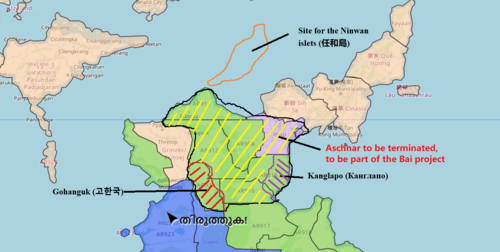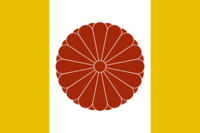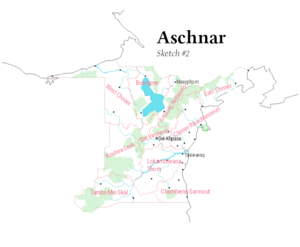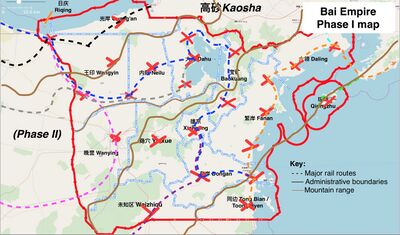Collab:Bai Empire: Difference between revisions
(Added more advanced section) |
|||
| Line 78: | Line 78: | ||
The geographic layout for the Empire (which has been mapped during the former Commonia period) will not drastically change. The central area will remain mountainous, with flatter fertile regions at the north and eastern coasts. Some of the existing major rivers will not be erased, but their course may be modified accordingly to be topographically consistent. There will also be some changes to the coastline to make them more detailed and natural. The boundaries will also shift once the geographic features are mapped. | The geographic layout for the Empire (which has been mapped during the former Commonia period) will not drastically change. The central area will remain mountainous, with flatter fertile regions at the north and eastern coasts. Some of the existing major rivers will not be erased, but their course may be modified accordingly to be topographically consistent. There will also be some changes to the coastline to make them more detailed and natural. The boundaries will also shift once the geographic features are mapped. | ||
Please see the "More Advanced Projects" section for projects related to the national geography. | |||
==Culture and language== | ==Culture and language== | ||
| Line 116: | Line 118: | ||
|{{relation|219524|日庆 Riqing}} | |{{relation|219524|日庆 Riqing}} | ||
|Modern city and a regional economic centre of Phase I. Based on Tianjin but Teochew speaking (i.e. Chaozhou in the style of Tianjin). | |Modern city and a regional economic centre of Phase I. Based on Tianjin but Teochew speaking (i.e. Chaozhou in the style of Tianjin). | ||
| style="background:#66cc22; border:2px solid #111111; padding:1em" | [[File:Emb-green.png|20px]] Open for collaboration.Anyone is free to propose their plan for the city, because I honestly don't have one at the moment, and have no immediate plans to develop the area. | | style="background:#66cc22; border:2px solid #111111; padding:1em" | [[File:Emb-green.png|20px]] Open for collaboration. Anyone is free to propose their plan for the city, because I honestly don't have one at the moment, and have no immediate plans to develop the area. | ||
|- | |- | ||
|{{relation|245313|东海港 Port Dunghoi}} | |{{relation|245313|东海港 Port Dunghoi}} | ||
| Line 218: | Line 220: | ||
| Literally meaning "Hidden caves", this will require some experience in mountain mapping. Some mining industries may exist, or abandoned during the devastating Warlord Era. | | Literally meaning "Hidden caves", this will require some experience in mountain mapping. Some mining industries may exist, or abandoned during the devastating Warlord Era. | ||
| style="background:#66cc22; border:2px solid #111111; padding:1em" | [[File:Emb-yellow.png|20px]] Available as long as you can provide a suitable plan | | style="background:#66cc22; border:2px solid #111111; padding:1em" | [[File:Emb-yellow.png|20px]] Available as long as you can provide a suitable plan | ||
|} | |||
===More advanced projects=== | |||
These are more advanced projects that are recommended only for more experienced mappers. While the current scope of these projects is limited to the area within Phase I, please be mindful that these will be expanded into Phases II and beyond. For these projects, please indicate the project ID in the subject line when messaging me. | |||
{| class="wikitable sortable" style="width:70%" | |||
! Project ID | |||
! Project Description | |||
! Map area | |||
! Project Status | |||
|- | |||
|BG-001 | |||
|Create a topo map for the Bai Empire | |||
| | |||
| style="background:#66cc22; border:2px solid #111111; padding:1em" |[[File:Achtung.svg|20px]] Available but recommended only for more advanced mappers | |||
|} | |} | ||
Revision as of 13:27, 20 September 2021
|
Located on Northern Archanta, the Bai Empire∈⊾ (百帝国) is a Chinese-speaking country that was once a colonial power. While China is the main inspiration, with the country taking up the Chinese culture, heritage and language, the Empire is not intended to be a carbon copy of the China we know today. Think of the project to be an answer to what a functioning, modern Chinese Empire will be like.
As for now, the project is limited to an area the size of South Korea (at 123,145.80 km²). It will be further expanded in the near future, with plans in progress for affiliated projects of other East Asian cultures (Japan, Korea, Tibet etc). The project is being led by me, Zhenkang, and anyone interested in participating is welcome.
General Information
The Bai Empire is intended to have a strong economy with moderate levels of development. Even at its fullest extent, Bai might be at most a regional power, and not a formidable emerging power like the China we know. As a regional power, Bai will have a strong influence on the regional history and culture. Close coordination will be required if you happen to be a neighbour of Bai.
For now, as we remain in Phase I, only limited aspects of the Chinese regions are incorporated as inspirations. See the Phase I section for details.

Orange for Ninwa (Japan), Red for Gohanguk (Korea),[1] Yellow for the Bai Empire and Purple for my personal conlang project Kanglapo
The Emperor's Commandments
While these are more of guidelines than actual rules, please adhere to them unless granted permission to do so otherwise.
- OGF rules also apply here. Adhere to them as well.
- Only map in Chinese, with no Latin transliterations (e.g. "雄京" and not "雄京 Xiongjing")
- Even if you don't speak Chinese, but is still able to map an East Asian-style city, leave the naming and translation to us.
- To display dialects, most likely other scripts will be used (can be Bopofomo, Katakana or Hangeul). So far, there isn't really a consensus for this yet.
- Follow the guidelines of the province/city you are mapping in.
- The OGF map is set in modern times, so don't map as though it was in a past dynasty (though if you want to, you can develop your mapping across time to help give some sort of realistic organic growth to your mapping. Just ensure the end product is the mapping we see today.)
- Please do not make drastic changes to the national geography, rivers and infrastructure (roads and rails) without the permission of the coordinator (namely me)
- The provinces are part of the Bai Empire. Please do not join the treacherous ways of Kaosha and Dehua (Cinasia) and declare independence for your own province. Independence movements may exist (especially for Hainan-speaking Qiongzhu) and there can be former brief independent republics that existed during the Warlord Era. However, back to rule no. 4, the map is set to what the area is today.
Contributors
Anyone with a background, interest, and/or understanding of Chinese culture and history is welcome to join in the project. (It is not necessary to have proficiency in the Chinese language.) Mappers may claim their own province, or sign-up to be part of the three collaborative projects (detailed in the following sections).
To indicate your interest in joining the Bai Empire Project, please ask on the discussion page or message me personally.
To-do list
There are plenty of stuff that is needed to be done. Any help is welcomed.
Meta
National-level mapping:
Xiongjing (capital):
|
History
To see the lore of the Bai Empire, read this article.
The history of Bai is long and eventful. In the 12th century, the First Bai Dynasty was established after centuries of divisions and war. It was succeeded by the Suo, after a Ninwan (or a foreign power) conquest in the 13th to 14th centuries, similar to the Mongol-led Yuan Dynasty. During the Suo, the Bai Empire set out its colonial exploits, establishing new colonies beyond Northern Archanta and Eastern Uletha. These colonisation projects wouldn't last, due to dwindling funds that drained the Empire's economy.
The "Dark Period" of Bai came in the 16th century when corrupt bureaucrats and merchants led to the Suo's collapse and the Lin was established. During this period, Bai gave up many of its colonial possessions through pacts with the West Ulethan colonial powers, which were also given control over parts of the Empire proper. The Middle Bai came in the 17th century, which established the semi-constitutional monarchy (influences from the West). This dynasty was considered the "peak" of modern Bai but collapsed with the rise of radical ideologies such as Bai Fascism and communism.
The War of Fellow Brothers erupted after the fascists gained power and overthrew the monarchy. The fascists, rather expansionist and with a need for resources, waged war with their regional neighbours. While they were eventually put down with a coalition of resistance forces, its collapse led to the Warlord Era, where many factions competed for influence. The New Bai Dynasty only came about in the 1960s, and the Empire rapidly recovered economically to regain its influence in the region.
Geography
A (sketch of a) topological map is needed to determine the major geographic features and the major road and rail infrastructures.
The geographic layout for the Empire (which has been mapped during the former Commonia period) will not drastically change. The central area will remain mountainous, with flatter fertile regions at the north and eastern coasts. Some of the existing major rivers will not be erased, but their course may be modified accordingly to be topographically consistent. There will also be some changes to the coastline to make them more detailed and natural. The boundaries will also shift once the geographic features are mapped.
Please see the "More Advanced Projects" section for projects related to the national geography.
Culture and language
The main language used is Mandarin Chinese, the main script Simplified. However, certain regions and states may use other dialects like Cantonese (e.g. Port Dunghoi), Hainanese, Hakka, Hokkien, Shanghainese, and Teochew. For the transcription of dialects, it is encouraged to use a non-Latin script like Bopofomo, Hangeul or Kana.
National infrastructure
Road network
Main article: Collab:Bai Empire/National Roads
The_Cute_Chick has kindly helped sketched the road and rail network in the Bai Empire. Meanwhile, kengoman has drawn up a detailed documentation for the national road mapping convention.
Please bear in mind a few things:
- The Empire is left-hand driving.
- Please do not make drastic changes to the road network without permission.
- If you want to build a cross-country road (whether motorway or normal trunk country road), please message me and I will check on your proposal
- Adhere to the documentation (relinked it here, in case you miss it).
Rail network
Main article: Collab:Bai Empire/BaiRail
More to come...
Phase I
The first phase∈⊾ consists of 13 provinces and 3 municipalities. Phase I comprises the more important regions of the empire. These include the mapping of the capital Xiongjing and two major cities Riqing and Port Dunghoi. Inspirations for the area is derived from much of real-world southern China provinces: Shaanxi, Hunan, Hubei and Guangdong provinces. (As Bai is set to expand in the near future, only limited aspects of the vast Chinese culture will be incorporated for this phase. That said, I cannot stop you from taking inspiration from other parts of real-world China).
Municipalities and major cities
These major cities are open for collaboration. All mappers, including those who have taken ownership of a province, are welcome to help develop these cities. Their descriptions are as follows:
| Name | Description | Status |
|---|---|---|
| 雄京 Xiongjing∈⊾ | The cultural and political centre of the Empire, with a layout similar to Chengdu. The contemporary capital will feature a "forbidden city" and a few other historical landmarks (e.g. palaces and tombs of late emperors) alongside "modern" government institutes like the Cabinet, the upper and lower houses of the legislature, and other government departments. The city will see a delicate balance between tradition and modernisation. It is a rather recent development, constructed in the 18th century on older architecture and infrastructure. See this page for more information. | |
| 日庆 Riqing∈⊾ | Modern city and a regional economic centre of Phase I. Based on Tianjin but Teochew speaking (i.e. Chaozhou in the style of Tianjin). | |
| 东海港 Port Dunghoi∈⊾ | As the name suggests (meaning "East Sea Port"), the city will be a major port of the east coast of the Empire. The city will be mapped in Cantonese. It is modelled mainly on Guangzhou (i.e. plenty of manufacturing zones), but also inspired by the (Guangdong-Hong Kong-Macau) Greater Bay Area (i.e. the coastal areas inspired by Macau and Hong Kong, the inner areas a technology and research hub like Shenzhen, etc). |
Provinces
The description of the 13 provinces is as follows. Each province has a suggested level of development, with different recommendations for mappers interested in adopting a province. In addition to the above three collaborative projects:
- Level 1 provinces are the least-developed provinces in the Bai Empire. The largest town in each Level 1 province (namely the capital) is expected to be roughly 500,000 residents, with a total population of about 2,000,000 residents.
- Level 2 provinces are somewhat more developed than Level 1 provinces, but are still primarily rural. These provinces may include some light industrial uses (factories, manufacturing, warehouses, etc.) near their largest city of +/- 1,000,000 residents. Level 2 provinces as a whole are expected to have fewer than 5,000,000 residents.
- Level 3 provinces are the most developed provinces in the Empire, containing at least one major settlement. Each city has a population of up to 5,000,000 residents. These provinces are also assumed to include an airport and at least one state university. Total population is upwards of 20,000,000.
These subdivisions can be taken up by one or more mappers. They have the freedom to map as they wish within it, subject to general overarching guidelines of each province (e.g. geography, railways, motorways) for consistency across the Project. Mappers are also encouraged to keep their provinces open for collaboration by other mappers, especially for the urban centres.
| Name | Level | Area (in km²) | Description | Status |
|---|---|---|---|---|
| 宝矿 Baokuang∈⊾ | 2 | 8157.96 | While rural, the province hosts many mines of valuable resources. Although with a Level 2, the province will feature plenty of railways and infrastructure for transporting these resources. | |
| 大湖 Dahu∈⊾ | 2 | 10725.25 | Next to the Great Lake, this area will feature an ancient, majestic city like Xi'an. Can be based off Shaanxi Province | |
| 大领 Daling∈⊾ | 2 | 11122.24 | The border region, this area will feature a few ports and industries. Can have plenty of Kalmish influences from neighbouring Kaosha. | |
| 东岸 Dongan∈⊾ | 3 | 11654.04 | The Cantonese-speaking region, part of the region will have urban sprawl from Port Dunghoi. | |
| 繁岸 Fan'an∈⊾ | 3 | 17851.43 | Based on Hunan Province with at most two important cities by the coast. | |
| 光岸 Guang'an∈⊾ | 2 | 9241.21 | Northern Chaozhou (Teochew) region. When mapping please preserve the straight border along the tropic. Anyone with knowledge of Teochew is welcome. | |
| 内陆 Neilu∈⊾ | 2 | 8490.40 | An extension of the Teochew-speaking area. Largely plain and flat, with plenty of farms. | |
| 琼珠 Qiongzhu∈⊾ | 1 | 4125.28 | Likely based on Hainan (though not as tropical). Anyone with knowledge of Hainanese is welcome. | |
| 同边 Tong Bian∈⊾ | 2 | 7598.11 | An extension of the Cantonese speaking area, it could feature plenty of industries (e.g. electronic equipment, chemicals and textiles). It will border the communist country of Kanglapo to the south, so there will be plenty of Katayan enclaves. | |
| 王印 Wangyin∈⊾ | 3 | 15237.78 | An extension of the Teochew-speaking area. Largely plain and flat, it will see plenty of rail connections through the area. | |
| 晚营 Wanying∈⊾ | 1 | 14733.95 | A landlocked province, there is one city available for development. Ideas for developing the region are welcomed. | |
| 未知区 Weizhiqu∈⊾ | 1 | 11480.73 | Literally meaning "Unknown Region", this mythical area was a source of many legends and myths. Plenty of religious sites could be built in the high mountains. | |
| 隐穴 Yinxue∈⊾ | 1 | 13672.06 | Literally meaning "Hidden caves", this will require some experience in mountain mapping. Some mining industries may exist, or abandoned during the devastating Warlord Era. |
More advanced projects
These are more advanced projects that are recommended only for more experienced mappers. While the current scope of these projects is limited to the area within Phase I, please be mindful that these will be expanded into Phases II and beyond. For these projects, please indicate the project ID in the subject line when messaging me.
| Project ID | Project Description | Map area | Project Status |
|---|---|---|---|
| BG-001 | Create a topo map for the Bai Empire |
Phases II and III
Once Phase I is running smoothly, Phase II will commence. Phase II will include the opening of the rest of the Bai Empire. While users can claim some of the provinces to map for themselves, important industrial cities will be up for collaboration and managed by other users. These urban areas, which will be marked out on a national sketch map, will be modelled on other Chinese major cities like Wuhan, Chongqing or Dalian.
Phase III might include the opening of Gohanguk and Ninwa (it could be opened alongside Phase II or earlier). Disclaimer again, there may not border the Bai Empire and are still subject to admin plans. While I can set out a guideline on what I envision, I may not assume control of these projects, and the decision on what will they be like rests with future users.
Foreign relations
The Bai Empire is welcome to establish relations with many countries around the world.
| Building their embassy in your country | Building your embassy in their country |
|---|---|
 While the Bai Empire is welcome to establish relations, at this stage Bai is rather new and it is not ready to do so. Send me a message and we can sort things out. While the Bai Empire is welcome to establish relations, at this stage Bai is rather new and it is not ready to do so. Send me a message and we can sort things out.
|
 Xiongjing remains under construction and it is unadvisable to set up embassies in the capital. If you like to, however, feel free to send me a message. Xiongjing remains under construction and it is unadvisable to set up embassies in the capital. If you like to, however, feel free to send me a message.
|
Bai Quarter
You are welcome to establish overseas Bai neighbourhoods around the world. However, depending on our relations and history, the size may vary. Bai neighbourhoods could be named as Bai Quarter. For generic Oriental neighbourhoods, you can name them "Pan-Ardentic".
Notes
- ↑ Tentative placeholder name


